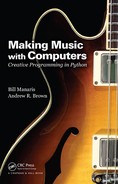References
Aristotle (1992). Complete Works, vol. 10. “Metaphysics I,” Hatzopoulos, O. (ed.). Kaktos, Athens, Greece (in Greek).
Arnheim, R. (1971). Entropy and Art: An Essay on Disorder and Order. London: University of California Press.
Ashton, A. (2003). Harmonograph: A Visual Guide to the Mathematics of Music. New York: Wooden Books.
Bak, P. (1996). How Nature Works: The Science of Self-Organized Criticality. New York: Springer-Verlag.
Beer, M. (2008). “Mathematics and music: Relating science to arts?” Mathematical Spectrum, 41(1): 36–42.
Berendt, J.-E. (1991). “Before we make music, the music makes us.” In The World Is Sound, chap. 4, pp. 57–75. Rochester: Destiny Books.
Calter, P.A. (2008). Squaring the Circle: Geometry in Art and Architecture. New York: John Wiley & Sons.
Capra, F. (1991). “Foreword.” In J.-E. Berendt, The World Is Sound, pp. xi–xiii. Rochester: Destiny Books.
Charton, É. and Cazeaux, E., eds. (1874). Magasin Pittoresque.
Chomsky, N. (1957). Syntactic Structures. The Hague, Holland Mouton.
Clark, M. A. (2005). “Genetic Music: An Annotated Source List.” Published online November 2, 2005, http://www.whozoo.org/mac/Music/Sources.htm.
Cook, N. (1990). Music, Imagination and Culture. Oxford: Oxford University Press.
Cooke, R. L. (2005). The History of Mathematics: A Brief Course, 2nd ed. Hoboken, NS: Wiley.
Cope, D. (2004). Virtual Music: Computer Synthesis of Musical Style. Cambridge, MIT Press.
Cope. D. (2013). “Experiments in Musical Intelligence.” Accessed online—http://artsites.ucsc.edu/faculty/cope/experiments.htm.
Eco, U. (1988). “The aesthetics of proportion.” In Art and Beauty in the Middle Ages, chap. 3, pp. 28–42. New Haven, CT: Yale University Press.
Gardner, H. (1985). The Mind’s New Science: A History of the Cognitive Revolution. New York: Basic Books.
Garland, T. H. and Kahn, C. V. (1995). Math and Music: Harmonious Connections. Palo Alto: Dale Seymour Publications.
Grant, E. (2009). “Making Sound Visible through Cymatics.” TED Talk [Video file]. Retrieved from https://www.ted.com/talks/lang/en/evan_grant_cymatics.html.
Greenberg, S. et al. (2011). Sketching User Experiences: The Workbook. Morgan Kaufmann.
Hemenway, P. (2005). Divine Proportion: Φ (Phi) in Art, Nature, and Science. Sterling Publishing.
Hofstadter, D. (1979). Gödel, Escher, Bach: An Eternal Golden Braid. New York: Basic Books.
James, J. (1995). The Music of the Spheres: Music, Science, and the Natural Order of the Universe. Copernicus.
Kepler, J. (1619). Harmonices Mundi (trans. by Charles Wallis, “Harmonies of the World,” Hong Kong: Forgotten Books, 2008).
Levine, M. (1995). The Jazz Theory Book. Petaluma, CA: Sher Music Co.
Livio, M. (2002). The Golden Ratio. New York: Broadway Books.
Magnusson, T. (2010). “Designing constraints: Composing and performing with digital musical systems.” Computer Music Journal, 34(4): 62–73. MIT Press, Winter.
Manaris, B. et al. (2005). “Zipf’s law, music classification and aesthetics.” Computer Music Journal, 29(1): 55–69. MIT Press, Spring.
Manaris, B. et al. (2006). “Investigating Esperanto’s statistical proportions relative to other languages using neural networks and Zipf’s law,” Proceedings of the 2006 IASTED International Conference on Artificial Intelligence and Applications (AIA 2006). Innsbruck, Austria, February.
Manaris, B. et al. (2007). “A corpus-based hybrid approach to music analysis and composition.” Proceedings of 22nd Conference on Artificial Intelligence (AAAI-07), Vancouver, BC, pp. 839–845, July.
Mandelbrot, B. B. (1982). The Fractal Geometry of Nature. New York: W. H. Freeman and Company.
Martineau, J. (2002). A Little Book of Coincidence. New York: Wooden Books.
May, M. (1996). “Did Mozart Use the Golden Section?” American Scientist, 84(1): 118–119.
Miranda, E. R. (2001). Composing Music with Computers. Oxford: Focal Press.
Moggridge, B. (2007). Designing Interactions. Cambridge: The MIT Press, pp. 704–706.
Nielsen, J. (2000). Why You Only Need to Test with 5 Users. Nielsen Norman Group. Retrieved from http://www.nngroup.com/articles/why-you-only-need-to-test-with-5-users/
Pickover, C. A. (1991). Computers and the Imagination. New York: St. Martin’s Press.
Pickover, C. A. (2002). The Zen of Magic Squares, Circles, and Stars: An Exhibition of Surprising Structures across Dimensions. Princeton NS: Princeton University Press.
Rushkoff, D. (2010). Program or Be Programmed—Ten Commands for a Digital Age. New York: OR Books.
Reynolds, C.W. (1987). Flocks, Herds and Schools: A distributed behavioral model. Computer Graphics, 21(4), 25–34.
Scaletti, C. (1993). “Sonification—an ancient idea made feasible by new technology.” ACM SIGRAPH ‘93—Course Notes 81, August 1993, p. 4.2.
Schwanauer, S. and Levitt, D. (1993). Machine Models of Music. Cambridge, MA: MIT Press.
Scruton, R. (1983). Understanding Music. Ratio, 25, 97–120.
Smith, T. A. (1996). “Fourteen Canons on the First Eight Notes of the Goldberg Ground (BWV 1087).” Accessed online—http://www2.nau.edu/tas3/fourteencanonsgg.html.
Schroeder, M. (1991). Fractals, Chaos, Power Laws: Minutes from an Infinite Paradise. New York: W. H. Freeman.
Stone, D. et al. (2005). User Interface Design and Evaluation. Morgan Kaufmann.
Surmani, A., Surmani, K. F., and Manus, M (1999). Alfred’s Essentials of Music Theory. Van Nuys, CA: Alfred Publishing Co.
Takahashi, R. and Miller, J. H. (2007). “Conversion of Amino-Acid Sequence in Proteins to Classical Music: Search for Auditory Patterns.” Genome Biology, 8(5): 405, published online May 3, 2007, http://www.ncbi.nlm.nih.gov/pmc/articles/PMC1929127.
Valle, A. et al. (2010). “In a concrete space—reconstructing the spatialization of Iannis Xenakis’ Concret PH on a multichannel setup.” Proceedings of the Sound and Music Computing Conference (SMC-2010). Barcelona, Spain, 21–24 July.
Vallianatos, E. (2012). “Deciphering and appeasing the heavens: The history and fate of an ancient Greek computer.” Leonardo, 45(3): 250–257.
Watkins, M. (2001). Useful Mathematical and Physical Formulae. Virginia: Walker & Company.
Xenakis, I. (1971). Formalized Music: Thought and Mathematics in Composition. Indiana University Press.
Zelle, J. M. (2004). Python Programming: An Introduction to Computer Science. Franklin, Beedle & Associates, Inc.
Zbikowski, L. M. (2005). Conceptualizing Music: Cognitive Structure, Theory, and Analysis. Oxford, UK: Oxford University Press.
Zipf, G. K. (1949). Human Behavior and the Principle of Least Effort: An Introduction to Human Ecology. Eastford, CT: Martino Fine Books (2012 reprint of 1949 edition).
